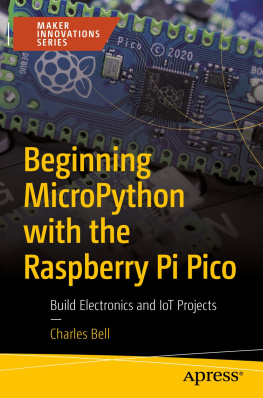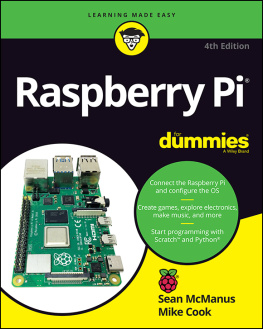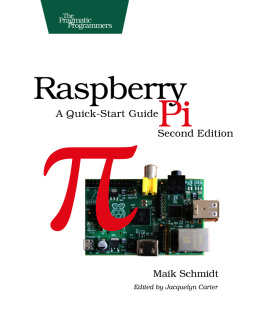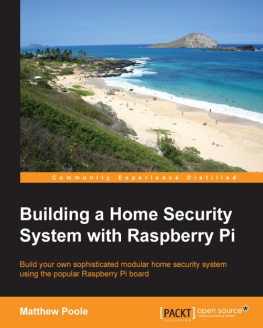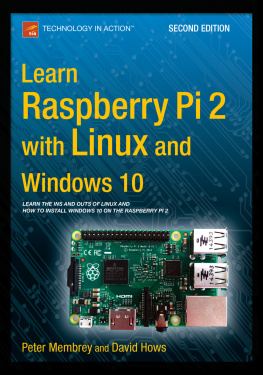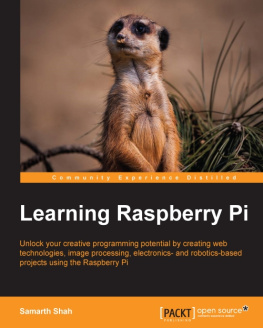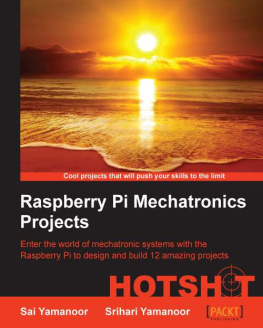
Introduction
The core idea behind the Raspberry Pi (RPi) project was the development of a small and affordable computing platform that could be used to stimulate the interest of children in core information and communications technology (ICT) education. The rapid evolution of low-cost system on a chip (SoC) devices for mobile applications made it possible to widely deliver the affordable RPi platform in early 2012. The impact was immediate; by February 2015, more than five million Raspberry Pi boards were sold. Given the proliferation of smartphones, the idea of holding in one hand computers that are capable of performing billions of instructions per second is easy to take for granted, but the fact that you can modify the hardware and software of such small yet powerful devices and adapt them to suit your own needs and create your own inventions is nothing short of amazing. Even better, you can now purchase a Raspberry Pi Zero for as little as $5 (the price of a large cup of coffee)!
The Raspberry Pi boards on their own are too complex to be used by a general audience; it is the ability of the boards to run embedded Linux in particular that makes the resulting platform accessible, adaptable, and powerful. Together, Linux and embedded systems enable ease of development for devices that can meet future challenges in smart buildings, the Internet of Things (IoT), robotics, smart energy, smart cities, human-computer interaction (HCI), cyber-physical systems, 3D printing, advanced vehicular systems, and many, many more applications.
The integration of high-level Linux software and low-level electronics represents a paradigm shift in embedded systems development. It is revolutionary that you can build a low-level electronics circuit and then install a Linux web server, using only a few short commands, so that the circuit can be controlled over the Internet. You can easily use the Raspberry Pi as a general-purpose Linux computer, but it is vastly more challenging and interesting to get underneath the hood and fully interface it to electronic circuits of your own designand that is where this book comes in!
This book should have widespread appeal for inventors, makers, students, entrepreneurs, hackers, artists, dreamersin short, anybody who wants to bring the power of embedded Linux to their products, inventions, creations, or projects and truly understand the RPi platform in detail. This is not a recipe book; with few exceptions, everything demonstrated here is explained at a level that will enable you to design, build, and debug your own extensions of the concepts presented. Nor does this book include any grand design project for which you must purchase a prescribed set of components and peripherals to achieve a very specific outcome. Rather, this book is about providing you with enough background knowledge and under-the-hood technical details to enable and motivate your own explorations.
I strongly believe in learning by doing, so I present low-cost, widely available hardware examples so that you can follow along. Using these hands-on examples, I describe what each step means in detail, so that when you substitute your own hardware components, modules, and peripherals you will be able to adapt the content in this book to suit your needs. As for that grand design project, that is up to you and your imagination!
In late 2014, I released a well-received book on the BeagleBone platform titled Exploring BeagleBone: Tools and Techniques for Building with Embedded Linux. Given the focus of this book on embedded Linux and the emphasis on introducing the core principles, there are some similarities between the introductory content in that book and this book. However, this book has been written from first principles purely for the RPi platform, focusing on its strengths and addressing several of its weaknesses. I also took the opportunity to extend the coverage of the material to cover topics such as Linux kernel development, the Arduino as a service processor, Wi-Fi sensor nodes, XBee communication, MQTT messaging, the Internet of Things (IoT), platform as a service (PaaS), and much more. If you have a copy of Exploring BeagleBone, you should visit this book's website (www.exploringrpi.com) to compare the content in both books before you make your purchasing decision.
When writing this book, I had the following aims and objectives:
- To explain embedded Linux and its interaction with electronic circuitstaking you through the topics and challenges on the popular RPi platform.
- To provide in-depth information and instruction on the Linux, electronics, and programming skills that are required to master a pretty wide and comprehensive variety of topics in this domain.
- To create a collection of practical Hello World hardware and software examples on each and every topic in the book, from low-level interfacing, general-purpose input/outputs (GPIOs), buses, bus-attached analog-to-digital converters (ADCs), and universal asynchronous receiver/transmitters (UARTs) to high-level libraries such as OpenCV and the Qt Framework. The book also covers more advanced topics such as low-level register manipulation and Linux loadable kernel module (LKM) development.
- To enhance and extend the interfacing capability of the RPi platform by developing frameworks for connecting it to circuits (e.g., SPI-based ADCs), to service processors (e.g., Arduino and NodeMCU), and to cloud-based IoT platforms and services.
- To ensure that each circuit and segment of code has a broad pedagogical reach and is specifically designed to work on the Raspberry Pi. Every single circuit and code example in this book was built and tested on the RPi platform (most on multiple board versions).
- To use the Hello World examples to build a library of code that you can use and adapt for your own Raspberry Pi projects.
- To make all the code available on GitHub in an easy-to-use form.
- To support this book with strong digital content, such as the videos on the DerekMolloyDCU YouTube channel, and the
www.exploringrpi.com custom website that was developed specifically to support this book. - To ensure that by the end of this book you have everything you need to imagine, create, and build advanced Raspberry Pi projects.
How This Book Is Structured
There is no doubt that some of the topics in this book are quite complex. After all, Raspberry Pi boards are complex devices! However, everything that you need to master them is present in this book within three major parts:
- : Raspberry Pi Basics
- : Interfacing, Controlling, and Communicating
- : Advanced Interfacing and Interaction
In the first part of the book, I introduce the hardware and software of the RPi platforms in , and subsequently provide three primer chapters:
- , Exploring Embedded Linux Systems
- , Interfacing Electronics
- , Programming on the Raspberry Pi
If you are a Linux expert, electronics wizard, and/or software guru, feel free to skip these primers. However, for everyone else, I have put in place a concise but detailed set of materials to ensure that you gain all the knowledge required to effectively and safely interface to the Raspberry Pi. The remaining chapters refer to these primers often.
The second part of the book, Chapters 611, provides detailed information on interfacing to the Raspberry Pi GPIOs, buses (I2C, SPI), UART devices, and USB peripherals. You learn how to configure a cross-compilation environment so that you can build large-scale software applications for the Raspberry Pi. , Real-Time Interfacing Using the Arduino, shows you how to use the Arduino as a slave processor with the Raspberry Pi, which helps you to overcome some of the real-time constraints of working with embedded Linux.
Next page


